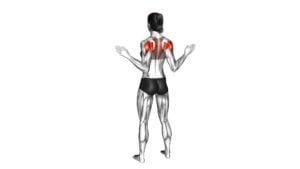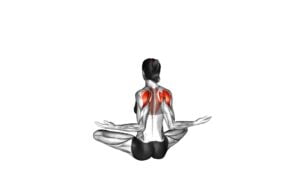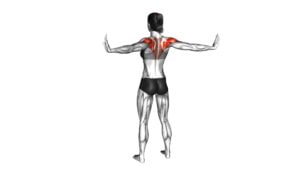Seated Pulse Back Squeeze (female) – Video Exercise Guide & Tips

Get ready to strengthen and tone your back with the Seated Pulse Back Squeeze.
Watch This Exercise Video
In this video exercise guide, you'll learn the proper form and technique for this effective workout.
Whether you're a beginner or advanced, there are modifications and progressions to suit all fitness levels.
Avoid common mistakes and maximize the effectiveness of this exercise with helpful tips.
Start incorporating the Seated Pulse Back Squeeze into your workout routine and feel the results.
Key Takeaways
- Improves posture and spinal alignment
- Reduces the risk of back pain and injuries
- Increases oxygen flow to muscles
- Enhances muscle performance
Benefits of the Seated Pulse Back Squeeze
You will experience numerous benefits from incorporating the seated pulse back squeeze into your workout routine. One of the key benefits is the importance of alignment. When performing this exercise, you're required to sit upright with your back straight and shoulders relaxed. This helps to improve your posture and spinal alignment, reducing the risk of back pain and injuries.
Another benefit is that the seated pulse back squeeze allows you to focus on your breathing techniques. As you squeeze your back muscles, you can synchronize your breath, inhaling deeply and exhaling slowly. This conscious breathing technique can help to increase oxygen flow to your muscles, improving their performance and aiding in relaxation.
By incorporating the seated pulse back squeeze into your workout routine, you can reap these benefits and more. It's essential to ensure proper form and technique for the exercise to maximize its effectiveness.
Transitioning into the subsequent section, we'll discuss the proper form and technique for performing the seated pulse back squeeze, ensuring you get the most out of this exercise.
Proper Form and Technique for the Exercise
To perform the Seated Pulse Back Squeeze exercise with proper form and technique, it's important to focus on alignment and muscle activation cues.
Keep your spine straight and shoulders relaxed, engaging your core for stability.
Visualize squeezing your shoulder blades together as you perform the movement, ensuring that you're targeting the correct muscles and maximizing the effectiveness of the exercise.
Importance of Alignment
Achieving proper alignment is crucial for maximizing the benefits of the Seated Pulse Back Squeeze exercise. Proper alignment ensures that you're engaging the correct muscles and targeting the intended areas of your back. By maintaining the correct form and technique, you can effectively strengthen your back muscles, improve posture, and reduce the risk of injury.
To achieve proper alignment, sit tall with your feet flat on the floor, your back straight, and your shoulders relaxed. Engage your core muscles to stabilize your spine and avoid slouching. As you perform the exercise, focus on squeezing your shoulder blades together without straining your neck or shoulders. Remember to breathe steadily throughout the movement.
Muscle Activation Cues
Maintaining proper alignment is key for maximizing the benefits of the Seated Pulse Back Squeeze exercise, as it ensures that you engage the correct muscles and target the intended areas of your back. To optimize muscle activation and exercise technique, follow these cues:
- Sit upright on the edge of a sturdy chair with your feet flat on the floor.
- Place your hands behind your head, elbows out to the sides.
- Squeeze your shoulder blades together, focusing on using your upper back muscles.
- Hold the squeeze for a moment, then release and repeat for the desired number of reps.
By following these cues, you'll activate your back muscles effectively and perform the exercise with proper form.
Now, let's explore modifications and progressions for all fitness levels.
Modifications and Progressions for All Fitness Levels
For optimal results and catered workouts, modify and progress the seated pulse back squeeze exercise based on your fitness level. No matter if you're a beginner or an advanced fitness enthusiast, there are modifications and progressions that can be made to ensure that you're challenging yourself appropriately.
If you're new to this exercise or have limited mobility, you can start by performing the seated pulse back squeeze with lighter weights or no weights at all. This will allow you to focus on the correct form and technique before adding intensity. As you become more comfortable and confident, you can gradually increase the weight or resistance to further challenge your muscles.
On the other hand, if you're already experienced and looking for a more advanced modification, you can try performing the seated pulse back squeeze on an unstable surface, such as a stability ball or a Bosu ball. This will engage your core muscles even more and provide an additional challenge to your balance and stability.
Remember to listen to your body and make modifications or progressions that suit your fitness level. By doing so, you can continue to make progress and avoid plateauing in your workouts.
Now that you understand how to modify and progress the seated pulse back squeeze exercise, let's move on to the next section and discuss common mistakes to avoid during the exercise.
Common Mistakes to Avoid During the Exercise
During the exercise, be mindful of the following common mistakes to avoid:
- Poor Posture:
Maintaining proper posture is crucial for the effectiveness of the seated pulse back squeeze. Avoid slouching or rounding your shoulders. Instead, sit upright with your chest lifted and your shoulder blades pulled back and down.
- Lack of Core Engagement:
Your core muscles play a significant role in stabilizing your body during the exercise. Failure to engage your core can lead to ineffective results and potential strain on your lower back. Remember to activate your core by drawing your belly button towards your spine.
- Overarching of the Lower Back:
Excessive arching of the lower back can put unnecessary stress on the spine and diminish the benefits of the exercise. Keep your lower back neutral by gently tucking your tailbone under and engaging your abdominal muscles.
- Incorrect Resistance:
Using too light or too heavy resistance can hinder your progress and increase the risk of injury. Choose a resistance band that challenges you without compromising your form. Start with a moderate resistance and adjust as needed.
Tips for Maximizing the Effectiveness of the Seated Pulse Back Squeeze
To maximize the effectiveness of the Seated Pulse Back Squeeze, it's important to maintain proper form throughout the exercise. Keep your back straight, shoulders relaxed, and engage your core muscles.
In addition, focus on your breathing, inhaling deeply as you squeeze your shoulder blades together and exhaling as you release.
Regular practice of this exercise can help strengthen your back muscles, improve posture, and alleviate tension in the upper body.
Proper Form Importance
Maintain proper form to maximize the effectiveness of the Seated Pulse Back Squeeze. Proper form is crucial when performing any exercise, including the Seated Pulse Back Squeeze. Here are some tips to help you maintain proper form and get the most out of this exercise:
- Importance of posture: Sit up straight with your feet flat on the floor. Keep your shoulders relaxed and your chest lifted. Maintaining good posture throughout the exercise will help target the correct muscles and prevent strain on your back.
- Engage your core: Before starting the exercise, engage your core muscles by pulling your belly button towards your spine. This will provide stability and support to your lower back.
- Don't rush: Take your time and perform the exercise slowly and controlled. Focus on squeezing your shoulder blades together and feeling the contraction in your back muscles.
- Avoid excessive weight: Start with a lighter weight and gradually increase as you get stronger. Using too much weight can compromise your form and increase the risk of injury.
Breathing Techniques During Exercise
Engaging proper breathing techniques is essential for maximizing the effectiveness of the Seated Pulse Back Squeeze. By focusing on your breath during the exercise, you can enhance your overall performance and increase the intensity of your workout.
When performing the Seated Pulse Back Squeeze, it's important to inhale deeply before initiating the movement. As you squeeze your shoulder blades together, exhale slowly and fully, focusing on contracting the muscles in your back.
This controlled breathing not only helps to oxygenate your muscles, but also engages your core and promotes better posture. By maintaining a steady and controlled breathing pattern, you can ensure that you're maximizing the benefits of the exercise and achieving optimal results.
Benefits of Regular Practice
For maximum effectiveness and results, regularly practice the Seated Pulse Back Squeeze to experience the benefits it offers. Here are some key reasons why incorporating this exercise into your routine can lead to long-term results and improve your mental well-being:
- Improved Posture: The Seated Pulse Back Squeeze targets the muscles of your upper back, helping to strengthen and improve your posture over time.
- Reduced Back Pain: By strengthening the muscles of your back, this exercise can help alleviate back pain and discomfort.
- Increased Core Stability: The Seated Pulse Back Squeeze engages your core muscles as well, promoting stability and balance.
- Enhanced Mental Well-being: Regular exercise, including the Seated Pulse Back Squeeze, has been shown to boost mood, reduce stress, and improve overall mental well-being.
Sample Workout Routine Incorporating the Seated Pulse Back Squeeze
To maximize the benefits of the seated pulse back squeeze, incorporate it into your workout routine. By including this exercise in your sample workout, you can effectively activate and strengthen the muscles in your back.
Here's a sample workout routine that incorporates the seated pulse back squeeze:
- Warm-up: Start with 5-10 minutes of light cardio to get your blood flowing and prepare your muscles.
- Seated Pulse Back Squeeze: Sit upright on a chair with your feet flat on the floor. Place your hands behind your head, elbows pointing outwards. Squeeze your shoulder blades together and hold for 2-3 seconds, then release. Repeat for 10-12 reps.
- Upper Body Strength Training: Incorporate exercises such as dumbbell rows, lat pulldowns, and bent-over rows to further engage and strengthen your back muscles. Aim for 2-3 sets of 10-12 reps for each exercise.
- Core Work: Strong core muscles are essential for proper posture and back support. Include exercises like planks, Russian twists, and bicycle crunches to target your abs and obliques.
- Cool Down and Stretch: Finish your workout with 5-10 minutes of light cardio and static stretches for your back, shoulders, and core.
Remember to listen to your body and adjust the intensity and repetitions as needed. Consistency is key to seeing progress, so aim to incorporate the seated pulse back squeeze and these exercises into your routine at least 2-3 times per week.
Frequently Asked Questions
How Many Repetitions Should I Do for the Seated Pulse Back Squeeze Exercise?
To determine the repetition range for the seated pulse back squeeze exercise, it's important to listen to your body and start with a comfortable number.
A good starting point is 8-12 repetitions per set.
As you become more comfortable, you can gradually increase the number of repetitions.
Can the Seated Pulse Back Squeeze Exercise Be Performed by Individuals With Lower Back Pain?
If you have lower back pain, it's important to modify exercises to ensure you don't aggravate your condition.
The seated pulse back squeeze exercise can be performed by individuals with lower back pain, but it's recommended to consult with a healthcare professional or a certified trainer for proper modifications.
Strengthening your back muscles can provide relief from lower back pain, so incorporating back strengthening exercises like the seated pulse back squeeze can be beneficial.
Is It Necessary to Use a Resistance Band for This Exercise, or Can It Be Done Without One?
To answer your question, you can perform the seated pulse back squeeze exercise without a resistance band. However, using a resistance band can provide additional benefits by increasing the intensity and adding resistance to the exercise.
If you don't have a resistance band, there are alternative equipment options you can use, such as dumbbells or even household items like water bottles. Remember to start with light weights and gradually increase as you get more comfortable with the exercise.
Can the Seated Pulse Back Squeeze Exercise Help Improve Posture?
Improving your posture is essential for maintaining a healthy and pain-free back.
Back exercises, like the seated pulse back squeeze, can be beneficial in achieving better posture. This exercise specifically targets the muscles in your upper back, helping to strengthen and stabilize them.
Are There Any Variations of the Seated Pulse Back Squeeze That Target Specific Muscles in the Back?
There are indeed variations of the seated pulse back squeeze that target specific muscles in the back. Modified back squeeze techniques can help you focus on different areas of your back, such as the upper back, lower back, or the muscles between your shoulder blades.
Conclusion
Incorporating the seated pulse back squeeze into your workout routine can provide numerous benefits for your back muscles. By focusing on proper form and technique, you can ensure that you're maximizing the effectiveness of this exercise.
Whether you're a beginner or advanced fitness enthusiast, there are modifications and progressions available to suit your fitness level. Avoid common mistakes and follow these tips to make the most out of your seated pulse back squeeze.
Start incorporating this exercise into your routine for a stronger and healthier back.

Author
Years ago, the spark of my life’s passion ignited in my mind the moment I stepped into the local gym for the first time. The inaugural bead of perspiration, the initial endeavor, the very first surge of endorphins, and a sense of pride that washed over me post-workout marked the beginning of my deep-seated interest in strength sports, fitness, and sports nutrition. This very curiosity blossomed rapidly into a profound fascination, propelling me to earn a Master’s degree in Physical Education from the Academy of Physical Education in Krakow, followed by a Sports Manager diploma from the Jagiellonian University. My journey of growth led me to gain more specialized qualifications, such as being a certified personal trainer with a focus on sports dietetics, a lifeguard, and an instructor for wellness and corrective gymnastics. Theoretical knowledge paired seamlessly with practical experience, reinforcing my belief that the transformation of individuals under my guidance was also a reflection of my personal growth. This belief holds true even today. Each day, I strive to push the boundaries and explore new realms. These realms gently elevate me to greater heights. The unique combination of passion for my field and the continuous quest for growth fuels my drive to break new ground.







